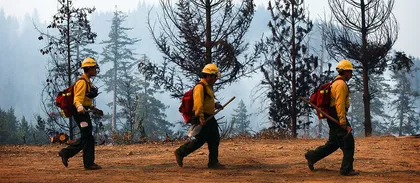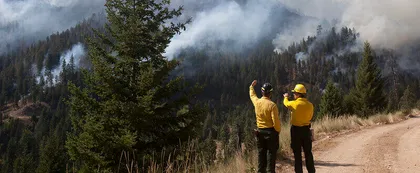About Wildfires
Fire Science
Preventing and fighting unwanted fires begins with understanding the science behind how they happen.

Fire occurs whenever combustible fuel in the presence of oxygen at an extremely high temperature becomes gas. Flames are the visual indicator of the heated gas.
Fire can also occur from lower-temperature sources. Over time, combustible materials such as smoldering embers can reach their ignition temperature.

Fire Triangle
The fire triangle is a simple way of understanding the elements of fire:
- Heat: Heat is responsible for the ignition and spread of fire.
- Fuel: Fuel is any material that will burn.
- Oxygen: Oxygen breaks down fuel and releases heat.

Wildfires involve many factors:
Fire Suppression: Fire suppression tactics are becoming increasingly complex especially with the increased residential development in wildland urban interface areas. Tactics include deploying professional firefighters, employing helicopters to drop water or fire retardants, or using bulldozers to create fire breaks.
Fuel Treatment: Treating or reducing fuels is part of active fire management. It reduces fuels, such as fallen leaves, branches, plant overgrowth, ladder fuels, and dead vegetation.
Ladder Fuels: Ladder fuels allow fire to spread vertically through vegetation from low (grass) to medium (bushes) to high (trees). On a single tree, the fire can spread from ground-level branches to mid-branches and eventually to the crowns (tops) of the trees.
Fire Seasons: Drier, hotter weather patterns produce longer fire seasons. Some areas experience two shorter fire seasons in spring and fall, while other areas experience one longer fire season throughout the summer. Build up of fuels and longer dry seasons have contributed to a "fire year" in some places, reflecting the year-long need to manage wildfires.
Topography: Topography refers to the physical features of the land itself, which can have an impact on wildfires. Variables such as slopes (including slope direction and position) and landforms (e.g. canyons, ridges, and basins ) can influence fire behavior.
Ecology and Other Factors: Overcrowded groups of similar trees and drought patterns may contribute to worse insect and disease outbreak cycles, which create large areas of dead and dying wood.

Learn more about wildfires
Fire is one of nature's most essential agents of change. They’re a powerful natural force we must fully understand, and respect, in order to best help control.